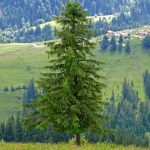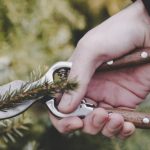
Have you noticed your once-vibrant conifer turning brown? It’s a common issue, and many people find it frustrating. But don’t be quick to worry, there’s still hope.
In this post, you will become familiar with proven methods to revive brown conifers. These steps also cover both prevention and treatment. So, let’s get right to it.
Table of Contents
How to tell if your conifer is dying
The good news is a conifer turning brown may not be dead yet. You need to check to be certain, though. Mind you, if you see most of the following signs, it’s probably on its way to the tree’s heaven, but let’s not get caught up in that at the moment.
- Look at the needles – Healthy conifers have green, flexible needles. If the whole tree has turned brown, it’s in serious trouble. Patches of brown could mean pests, disease, or weather damage. If only the lower branches are affected, it might not be getting enough light.
- Check the bark – Run your hand over the trunk. Healthy bark should feel firm and intact. If it’s cracked, peeling, or soft in places, the tree could be stressed, dehydrated, or suffering from disease.
- Inspect the roots – If your potted conifer is browning, poor drainage or root rot could be the issue. Smelly, soggy soil means the roots are drowning. If the soil is bone dry, the tree isn’t getting enough water.
- Watch for pests or fungi – Webbing, tiny holes, or sticky residue suggest an insect problem. White powder or black spots mean fungal disease could be spreading. Both weaken the tree fast if left untreated.
- Test the branches – If all branches snap easily and no green remains inside, the answer to “Is my conifer dead?” may just be positive.
Why do conifers go brown?
Several factors could be to blame for why your conifer is turning brown. Some of these could be your fault; others can happen regardless.
- Weather stress – Drought dries out needles, while too much water drowns roots. Both lead to conifers dying from the bottom up. In summer, strong sun scorches needles, especially on young or newly planted conifers. This explains why conifers go brown in summer. In winter, frost can damage tender shoots;
- Nutrient problems – A lack of nitrogen is a common issue. Without enough of it, growth slows, and needles fade to yellow or brown. Other nutrients, like magnesium and iron, also play a role. Poor soil conditions may strip essential minerals away;
- Pests and disease – Root rot is another threat which happens in wet soil. Affected trees lose needles, and branches turn brown from the inside out. Once the roots are damaged, recovery is difficult. Fungal infections like needle blight also spread quickly. White or black spores may appear on affected branches;
- Poor pruning – Conifers need careful pruning. Unlike some trees, they do not always regrow from old wood. Cutting too much at once weakens the tree. Removing large sections may leave permanent brown patches. Timing also matters a great deal. Pruning in early spring or late summer works best. You should avoid heavy cuts in winter, as this exposes fresh growth to frost damage.
- Growth pattern changes – If you’ve wondered, “Why do conifers go brown in the middle?” the answer often lies in light exposure. Lower branches may turn brown and die off when shaded by upper growth. The tree redirects energy to newer, sunlit areas. Dense planting can also contribute to this. When conifers grow too close together, airflow reduces, and inner branches get less light. This is common in mature hedges;
Can a brown conifer go green again?
A brown conifer may look lifeless, but it does not always mean the tree is dead. With the right care and when the cause is treated early, many trees can recover. Below are key steps on how you can try to revive a brown conifer and bring it back to life.
Mulching practices
Mulch helps roots retain moisture and protects them from extreme temperatures. Use organic mulch like bark, wood chips, or compost. Spread a 5 cm layer around the base, but keep it away from the trunk to prevent rot. Apply in spring or autumn to support healthy growth.
Fertilisation tips
You already know that a lack of nutrients weakens conifers. So, what fertiliser is good for conifers against the browning of needles? A slow-release fertiliser with nitrogen, phosphorus, and potassium works best.
Organic options like compost or seaweed feed help long-term health. Apply in early spring and late summer for best results.
Pruning methods
Trimming dead branches encourages new growth. Always use sharp tools to remove dry or damaged areas. Many may wonder, how much can you cut off the top of a conifer?
Avoid cutting too much, as conifers struggle to regrow from old wood. In that line of thought, can you cut the bottom branches of a conifer tree? Yes, but remove only a few at a time to avoid stressing the tree.
Disease and pest control
If you suspect a fungal issue, improve drainage and remove infected branches. Apply a fungicide in early spring or late summer to prevent further spread.
For pest infestations, look for signs. Examples include fine webbing from spider mites, sticky honeydew from aphids, or hard shell-like coatings from scale insects. Hose down the tree to remove mites or use insecticidal soap to treat affected areas. Prune overcrowded branches to improve airflow, as this helps reduce both fungal growth and pest infestations.
Improve growing conditions
Conifers in pots often struggle due to space limits. Repot if the roots outgrow the container. For ground-planted trees, check the location. Too much sun or wind may cause browning. If needed, and if possible at all, reposition the tree or at least add wind protection.
How to prevent future browning
Some trees struggle more than others, so choose a resilient species suited to your local climate if you decide to start fresh. It will make a big difference. Once you plant it, follow these simple steps to stop browning before it even starts.
- Water the right way – Water deeply, not just at the surface. Shallow watering dries out quickly and weakens the roots. Give conifers a deep soak once a week during dry spells. In winter, reduce watering but avoid letting the soil dry out completely. Conifers in pots need more frequent checks, as their soil dries faster;
- Seasonal care – Each season brings different challenges. In spring, feed conifers with a balanced fertiliser to encourage strong growth. In summer, mulch around the base to retain moisture and protect roots from heat. Autumn is the best time to trim conifers lightly, removing any dead or weak branches. In winter, protect young trees from frost damage with a windbreak if needed;
- Prune for healthy growth – Prune with care. Heavy cuts harm conifers, especially older ones. When to prune conifers in the UK? Late summer to early autumn works best. Remove dead or damaged branches to help the tree focus on new growth. Avoid cutting into old wood, as many conifers do not regrow from it;
- Encourage strong growth – Do conifers regenerate? Some do, but only if pruned correctly and given proper care. With that said, how do you encourage conifers to grow? Feed them well, keep their soil healthy, and prune lightly to shape them without stress.
What to do with a dead conifer hedge?
Not all conifers recover, sadly. Sometimes, a tree is too damaged to save. Knowing when to remove a dead conifer hedge is important. It helps prevent further problems in your garden like disease spread or pest infestations. And besides that, the dead tree just looks unsightly, so there’s that.
Before removing it, however, check if the hedge has any life left. Snap a twig—if it bends and shows green inside, the tree may still recover. If it breaks easily and is dry inside, the branch is dead. Brown needles that do not drop peeling bark, and brittle branches all point to a dead hedge.
If the hedge shows no signs of life, removal is the best option. Cut it down section by section to make the job easier. Dig out the roots to stop regrowth and clear the area for replanting.
On a side note, how long do conifers live when they are healthy and in great condition? Both trees and hedges can grow for decades. For dwarf conifers or hedge varieties like Leylandii, lifespans are usually 30–50 years with proper care. Larger conifer trees, such as Scots pine, Douglas fir, or cedar, can live 100–500 years. However, poor conditions or disease often shorten their lifespan.
How much does it cost to remove a conifer tree UK?
In 2025, the average cost to remove a conifer tree in the UK ranges from £300 to £1,000. Prices vary based on the tree’s size, location, and the complexity of the job.
For smaller trees, cutting at the base with a chainsaw or handsaw may suffice. You can even do it yourself if you have the instrument and the time. Larger conifers, on the other hand, need careful planning to avoid damage to nearby structures or plants. They need a professional tree surgeon to handle the job and for good reason.
Tree removal experts assess the tree’s size, condition, and location to choose the safest approach. They cut branches first, working from the top down to prevent damage. Using chainsaws, ropes, and rigging equipment, they lower heavy sections carefully.
Once the trunk is removed, they grind or extract the stump if needed. Finally, they handle cleanup, by chipping branches and disposing of waste. Their skills and tools make the process quick, safe, and hassle-free.
Your tree needs a makeover? Check our tree surgery schedule.
Enter your postcode to view our rates and availability in your area.
For questions about the services we offer visit our main site
Takeaways
- Even if your conifer is turning brown, it may still recover with the right care;
- Common causes of browning include weather stress, nutrient deficiencies, pests, disease, and improper pruning;
- How you revive a brown conifer is by mulching, fertilisation, pruning and pest control;
- To prevent future browning, you need to deep water and prune lightly;
- If all branches snap easily, bark peels off, and no green remains, the tree is likely dead and should be removed;



